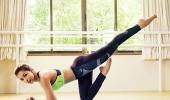Dr Hansaji Yogendra, director of The Yoga Institute in Mumbai, tells you how to ensure a healthy 2024 with 10 asanas.
- Health-related questions? Ask Rediff's Health Gurus HERE.

Kindly note the image has been posted only for representational purposes. Photograph: Kind courtesy Kunal Khemmu/Instagram
In recent years, we have seen millions of people worldwide practice yoga on a daily basis.
While the journey of yoga is lifelong, some asanas offer both simplicity and profound benefits.
Whether you're a yoga sadhak or someone new to the practice, here are 10 asanas you can try to master in 2024 and set the tone for a harmonious year ahead.
- Health-related questions? Ask Rediff's Health Gurus HERE.
All photographs: Kind courtesy Dr Hansaji Yogendra/The Yoga Insitute
1. Stithprarthanasana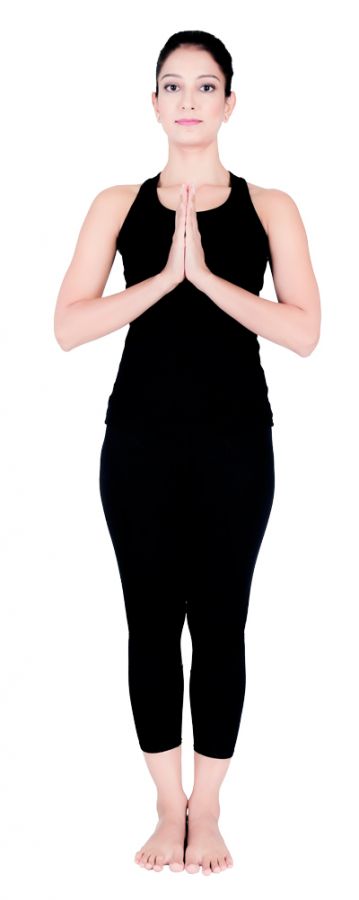 How to do it
How to do it
- Stand erect, feet close together.
- Your knees should be straight but relaxed.
- Maintain a straight neck, abdomen in normal contour and chin drawn in.
- Keep your eyes focused straight ahead. Keep your mind calm.
- Fold hands in the namaskar mudra in front of the chest.
- Relax shoulders and elbows.
- Close your eyes focus on your breath.
- Open your eyes slowly and lower your hands to the starting position.
Benefits
- Enhances posture and co-ordination.
- Improves physical steadiness and voluntary muscular control.
- Calms the mind and nerves.
2. Garudasana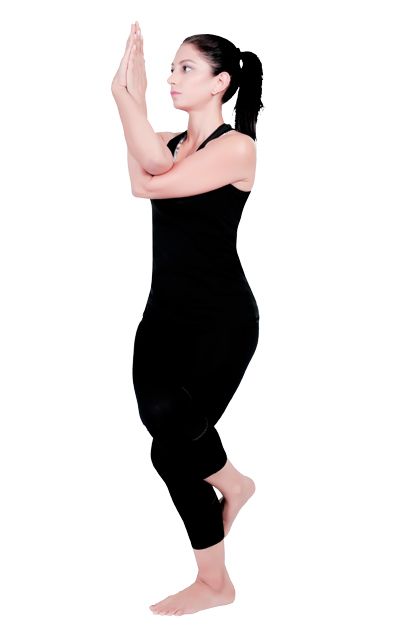 How to do it
How to do it
- Stand tall with your hands by your sides and your feet together.
- Keep your neck straight, chest forward, abdomen relaxed and chin tucked in, focusing on a fixed point ahead.
- Inhale, lifting your arms to shoulder height with your palms facing downwards.
- Exhale, lift your left leg, wrap around your right leg and secure by straightening your right leg.
- Simultaneously, cross your arms (left below right), intertwine at your elbows and join palms.
- Gaze straight, holding your breath momentarily.
- Inhale and release your legs and arms, returning to the starting position.
- Repeat steps with the right leg and arms to complete one round.
Benefits
- Strengthens and tones muscles, nerves and joints of the pelvis, legs, arms and shoulders.
- Enhances muscle tone and flexibility in thighs.
- Improves balance, endurance and neuro-muscular coordination.
3. Nataprarthanasana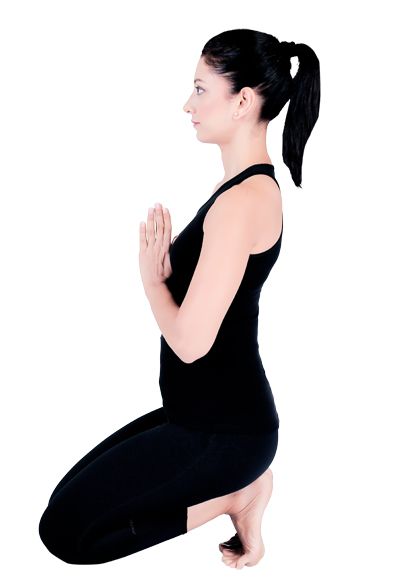 How to do it
How to do it
- Stand erect with your hands in prayer pose near the breastbone, chest forward, neck straight, feet together, abdomen relaxed and chin tucked in. Focus your gaze straight ahead.
- Inhale and raise heels gently off the ground.
- Exhale, bend your knees gently and lower your body to sit on your raised heels with your knees on the floor. Balance your weight between your knees and toe tips.
- Hold the position, suspend breath for twice the exhalation time.
- Inhale, lift your knees while balancing on your toes and rise with your heels raised.
- Exhale and lower your heels to the floor to return to the starting position.
Benefits
- Enhances flexibility in the hip and knee joints.
- Improves body balance.
- Strengthens lower back muscles.
4. Bhujangasana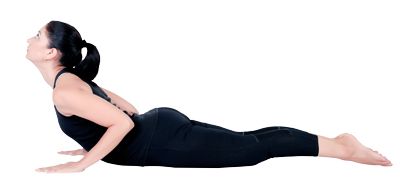 How to do it
How to do it
- Lie prone on a mat with your legs straight and feet together. Fold arms at elbows beside the chest, palms down, forehead resting on the mat.
- Inhale, slowly raise your head, neck, shoulders, thorax and upper abdomen rhythmically, using deep back muscles, creating a backward curve in the spine, lifting each vertebra sequentially.
- Hold the pose with retained breath.
- Exhale, gradually lower your back, thorax and neck to return to the starting position.
Benefits
- Tones deep muscles supports the spinal column and trunk.
- Massages and stimulates adrenal glands.
- Reduces constipation, flatulence and abdominal adhesions.
5. Yogendra Chakrasana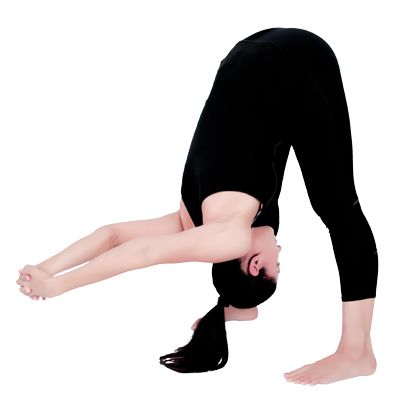 How to do it
How to do it
- Stand erect with your feet two feet apart from each other.
- Your neck must be straight, shoulders square, abdomen normal and chin tucked.
- Focus your eyes straight ahead.
- Inhale and clench your fists with the thumbs inside.
- Raise your arms close to your ears.
- Now arch back and thrust your hips forward.
- Exhale and bend forward.
- Interlock your fingers behind your back, bringing your head towards your knees.
- Hold this position for double exhalation time.
- Return to starting position.
- Inhale and unlock fingers and swing your arms down.
- Lift your body upright.
- Exhale, return your arms to sides.
Benefits
- Strengthens chest, waist, back, neck, spine, shoulders and core.
- Exercises both anterior and posterior body muscles.
- Acts preventively and remedially for constipation.
6. Hastapadangushtasana I How to do it
How to do it
- Stand straight with your feet together and hands by sides.
- Exhale, raise your right leg towards the right shoulder while simultaneously extending your right hand to hold the big toe of your right foot.
- Inhale, release the toe grip, and return your leg and hand to the starting position.
- Repeat the sequence with your left leg to complete one round.
Benefits
- Enhances flexibility and strength in the waist and hip joints.
- Tones and strengthens leg and arm muscles.
- Improves balance and posture.
7. Sarvangasana How to do it
How to do it
- Lie supine on the mat with your feet together and hands beside your body. Ensure a calm mind and relaxed body.
- Exhale, lift your legs to form a right angle with your body.
- Continuing the exhale, raise your torso, supporting your weight with your arms and elbows.
- Rest your chin in the jugular notch.
- To return, inhale while lowering your hips and legs back to the starting position.
Benefits
- Enhances spinal flexibility and nerve function.
- Increases blood flow to the brain.
- Benefits thyroid, parathyroid and pituitary glands.
8. Ekpadasana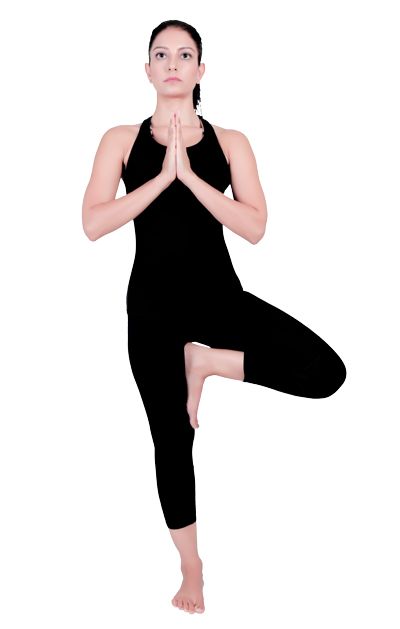 How to do it
How to do it
- Stand erect with your hands by sides and feet together.
- Maintain a straight neck, normal abdomen contour and chin drawn in.
- Fix your gaze on a single point ahead, ensuring a calm mind.
- Using your hands for support, lift your left leg and place its sole against your right thigh.
- Join your palms in front of your chest in a prayer position.
- Return to starting by gently lowering your left leg; repeat with your right leg.
Benefits
- Strengthens leg and spine muscles.
- Corrects flat feet and enhances body balance.
- Boosts endurance and alertness.
9. Dhanurvakrasana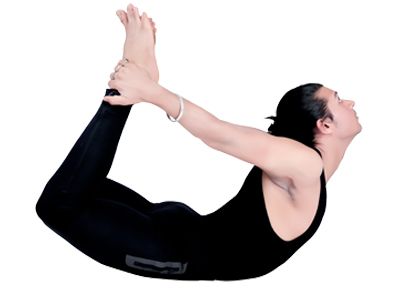 How to do it
How to do it
- Lie prone on a mat with your forehead down, legs straight and toes pointing out.
- Lift your head, bend your knees and grasp your ankles with your hands.
- Inhale and arch the spine.
- Raise the head and legs to form a bow shape with your toes pointing upwards.
- Hold the pose, retaining breath for double inhalation time.
- Exhale and lower your head.
- Release your ankles, returning to the starting position.
Benefits
- Opens chest, neck and shoulders.
- Enhances blood circulation in abdominal and reproductive organs.
- Alleviates constipation, flatulence and indigestion.
10. Hastapadasana How to do it
How to do it
- Stand erect, with hands by your sides and feet together.
- Fix your gaze forward on a single point.
- Inhale, raise hands above the head, arch back and keep your eyes open. Look upwards.
- Exhale, bend forward. Keep your legs straight, aim to touch your toes and position your head between your arms.
- Bend your elbows, grip your ankles and draw your head towards knees, placing your forehead on your knees.
- Inhale, release your ankles, raise your trunk, stretch your arms up and return your hands to your sides.
Benefits
- Stretches posterior muscles benefiting back, hips and hamstrings.
- Tones abdominal muscles, reducing unnecessary abdominal fat.
- Stimulates urogenital, digestive, nervous and endocrine systems.
As you integrate these 10 asanas into your daily routine, may you find moments of stillness, strengt, and a renewed sense of purpose.
Let this be the year where your yoga practice transcends the mat to bring you peace and equanimity.
- Health-related questions? Ask Rediff's Health Gurus HERE.
Disclaimer: All content and media herein is written and published online for informational purposes only. It is not a substitute for professional medical advice. It should not be relied on as your only source for advice.
Please always seek the guidance of your doctor or a qualified health professional with any questions you may have regarding your health or a medical condition. Do not ever disregard the advice of a medical professional, or delay in seeking it because of something you have read herein.
If you believe you may have a medical or mental health emergency, please call your doctor, go to the nearest hospital, or call emergency services or emergency helplines immediately. If you choose to rely on any information provided herein, you do so solely at your own risk.
Opinions expressed herein cannot necessarily provide advice to fit the exact specifics of the issues of the person requesting advice.


